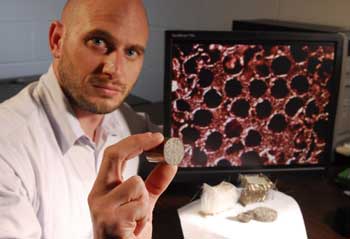Georgia Tech Research Institute (GTRI) research engineer Jason Nadler has developed a new material that can reduce the noise of aircraft engines.
The honeycomb-like structure is composed of many tiny tubes or channels that can reduce sound more effectively than conventional methods.
Most sound-deadening materials - such as foams or other cellular materials comprising many small cavities - exploit the fact that acoustic waves resonate through the air at various frequencies.
Just as air blowing into a bottle produces resonance at a particular tone, an acoustic wave hitting a cellular surface will resonate in certain-size cavities, thereby dissipating its energy. The drawback with the approach is that it only reduces noise at certain frequencies.
Nadler’s research involves broadband acoustic absorption, a method of reducing sound that doesn’t depend on the frequency of the noise or resonance.
In his approach, tiny parallel tubes in porous media such as metal or ceramics create a honeycomb-like structure that traps sound regardless of its frequency. Instead of resonating, sound waves enter the channels and dissipate through a process called viscous shear.
In researching this approach, Nadler constructed an early prototype from off-the-shelf capillary tubes, which readily formed a low-density, honeycomb-like structure. Further research showed that the ideal material for broadband acoustic absorption would require micron-scale diameter tubes and a much lower structural density.
Creating such low-density structures presents an interesting challenge, Nadler said. It requires a material that is light, strong enough to enable the walls between the tubes to be very thin, and yet robust enough to function reliably amid the high-temperature, aggressive environments inside aircraft engines.
Among the likely candidates are superalloys, materials that employ unusual blends of metals to achieve desired qualities such as extreme strength, tolerance of high temperatures and corrosion resistance.
Nadler has developed what could be the world’s first superalloy micro honeycomb using a nickel-base superalloy. At around 30 per cent density, the material is very light - a clear advantage for airborne applications - and also very strong and heat resistant.
He estimates this approach could attenuate aircraft engine noise by up to 30 per cent. Such a micro-honeycomb material could also provide a means to protect an aircraft in critical areas prone to impact from birds or other foreign objects by dissipating the energy of the collision.

GTRI research engineer Jason Nadler has developed a microchannelled material that reduces aircraft engine noise by wearing it down through a process called viscous shear










Guest blog: exploring opportunities for hydrogen combustion engines
"We wouldn't need to pillage the environment for the rare metals for batteries, magnets, or catalisers". Batteries don't use rare...